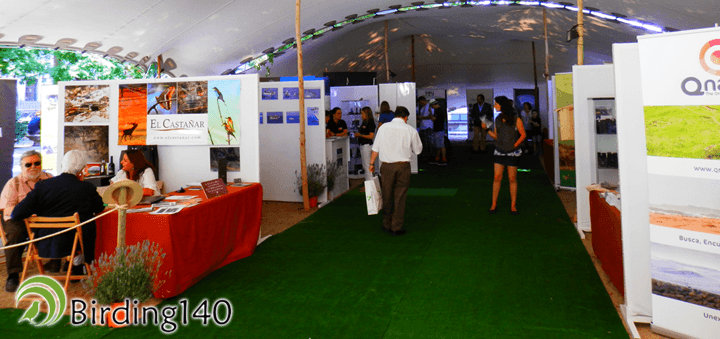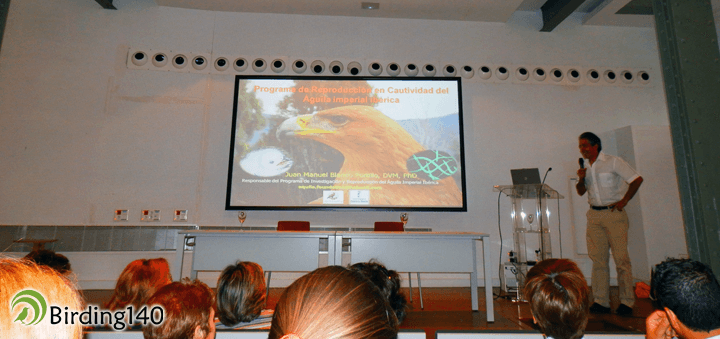From 13 to 15 June the first edition of MADbird Fair was held in Madrid. We programmed our visit the very moment we knew about the creation of this new bird fair. It looked good: unlike most ornithological fairs, it would be an urban fair located in the Paseo del Prado, very close to the Thyssen Museum and the Museo del Prado, guardian of the magnificent Bosch’s painting The Garden of Earthly Delights. It was also very close to the Royal Botanical Garden and El Retiro park.
June 13 arrived, the curtain went up and we could finally see MADbird Fair 2014. Two large tents were raised Right in the middle of the Spanish capital, creating a real urban oasis with birds, wolves, cetaceans and all kinds of proposals related to nature observation tourism. We found very interesting offers of rural accommodation; companies specialised in nature observation like Turmares, dedicated to whale spotting in the Strait of Gibraltar; or Llobu, probably the best specialist in wolf watching in the Iberian Peninsula, as well as information about the natural resources in various Spanish regions. We want to highlight two stands: the Community of Madrid one, with its splendid Guadarrama National Park, and the Birding Extremadura one, with its always powerful offer of ornithological tourism resources.
Two watching towers were also built in the small MADbird oasis. From them we could look up over the Paseo del Prado and, with a bit of luck, discover species like Rock Doves or Eurasian Collared Doves, Barn Swallows or Common House Martins, blackbirds or magpies, Monk Parakeets or sparrows, Eurasian Blue Tits or Great Tits, or even watch some of the Peregrine Falcons that dwell in the city. Unfortunately, we weren’t so lucky with the sightings, not as lucky anyway as those who, shortly after 4 pm on Friday, were baffled to discover a Spanish Imperial Eagle flying over the Paseo del Prado. The unexpected visitor dominated the skies of Madrid for quite a while until a Peregrine Falcon, defending its position as a big urban bird of prey, started harassing it to put it off from its territory.
The conference programme at MADbird has been the great success of the fair. Practically all talks were thrilling, although the capacity of the conference room was very limited. We left the fair regretting not having been able to attend the first release of the Cuento del Rabilargo (the tale of the magpie), a Hispanic-Chinese documentary about this strangely distributed beautiful bird, because the room was full and we couldn’t get in.
The conference of José Lara about emblematic birds in the Madrid region was specially interesting. During his talk, he described the evolution of the population of the Bonelli’s Eagle, the Black Stork, the Lesser Kestrel, the bustard, the Cinereous Vulture and, of course, the Spanish Imperial Eagle. He also described the challenges they face every day to survive, stressing the risk of collision against power lines and electrocution.
Also of special interest were the conferences of David Lindo —better known as “The Urban Birder”— about birds that dwell in major cities, and of Juan Manuel Blanco about the captivity reproduction programme of the Spanish Imperial Eagle carried out by Fundación Aquila. This programme is one of the foundations of the long-awaited and difficult recovery of the most endangered bird of prey in Europe. At the moment, despite the increase of the Imperial Eagle population, the number of couples remains so low, its genetic variability so limited and the possibility of captive breeding so difficult that it seems impossible to prevent its extinction in the medium term. Let’s hope the great efforts that are being carried out for its captive breeding are successful and the Imperial Eagle manages to avoid its fate.
The most striking conference of MADbird Fair 2014 dealt with the reality of conservation in Africa, and was held by Luis Arranz, director of the Garamba National Park. The talk started with the following words: “Conservation in Africa is a war and we are losing it”. Along the conference, Luis Arranz unveiled the titanic difficulties that Garamba National Park wardens have to face, how over thirty wardens have lost their lives during the last years in armed confrontations with poachers, and how the lack of political will to defend the natural environment and to enforce law undermines the efforts of conservation in Africa. Of the 23 000 elephants that lived in Garamba a few years ago, only about 3000 survive nowadays. According to Luis Arranz, if the security measures don’t increase, in about six years the elephants of Garamba will disappear, as happened with rhinoceros a few years ago.
Our visit to MADbird Fair 2014 has been a pleasant experience: the nature tourism offer available at the exhibitor’s stands was really interesting and the topics handled at the conferences was very thrilling. We hope the organizers decide to schedule a second MADbird. However, for the next edition we would like to suggest to organize a trip observe the city birds, given that Madrid has a lot of good places for birdwatching and, above all, to find a larger conference room. Despite some minor defects which are normal for a first edition, we can define MADbird 2014 as a small great fair. The visit was worth it.
If you have enjoyed this post please share it on your social networks.













